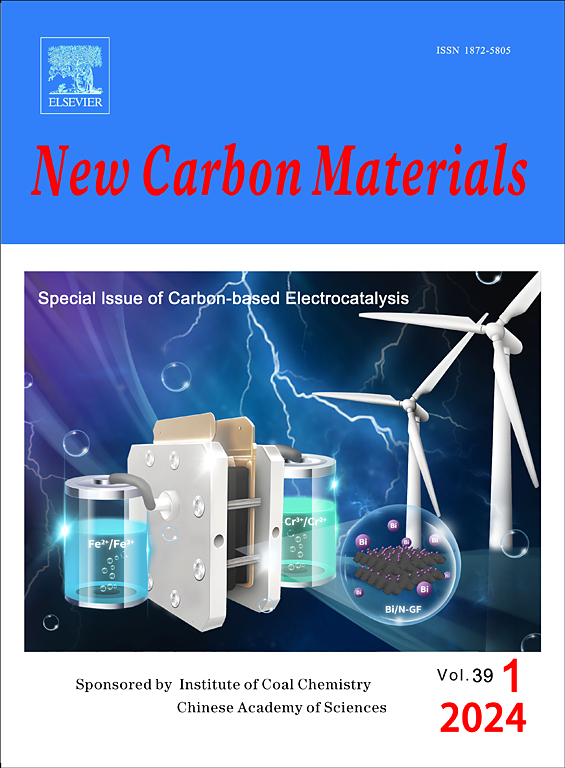用胶束共聚法制备P、N共掺杂中空碳纳米球,提高碱性水中析氢速率
IF 5.7
3区 材料科学
Q2 Materials Science
引用次数: 0
摘要
设计经济高效的无金属碳基析氢反应催化剂,对提高碱水电解制氢效率具有重要意义。杂原子掺杂对电子结构的精确控制已被证明是提高催化活性的有效方法。然而,无论是结构特征和潜在的机制都不太清楚,特别是掺杂两种不同的原子,从而限制了这些催化剂的使用。本文报道了吡咯和苯胺在Triton X-100胶束界面上共聚,然后掺杂植酸和碳化制备磷氮共掺杂空心碳纳米球(HCNs)。hcn独特的孔隙结构和富含缺陷的框架暴露了许多活性位点。至关重要的是,石墨氮和磷碳键的联合作用调节了相邻C原子的局部电子结构,促进了电子转移。结果表明,在1100℃下碳化的HCN在碱性水中表现出优异的HER活性和出色的稳定性(在10 mA cm−2电流密度下70 h),这是因为石墨氮和磷碳键的大量存在。下载:下载高清图片(98KB)下载:下载全尺寸图片本文章由计算机程序翻译,如有差异,请以英文原文为准。
P, N co-doped hollow carbon nanospheres prepared by micellar copolymerization for increased hydrogen evolution in alkaline water
The design of cost-effective and efficient metal-free carbon-based catalysts for the hydrogen evolution reaction (HER) is of great significance for increasing the production of clean hydrogen by the electrolysis of alkaline water. Precise control of the electronic structure by heteroatom doping has proven to be efficient for increasing catalytic activity. Nevertheless, both the structural characteristics and the underlying mechanism are not well understood, especially for doping with two different atoms, thus limiting the use of these catalysts. We report the production of phosphorus and nitrogen co-doped hollow carbon nanospheres (HCNs) by the copolymerization of pyrrole and aniline at a Triton X-100 micelle-interface, followed by doping with phytic acid and carbonization. The unique pore structure and defect-rich framework of the HCNs expose numerous active sites. Crucially, the combined effect of graphitic nitrogen and phosphorus-carbon bonds modulate the local electronic structure of adjacent C atoms and facilitates electron transfer. As a result, the HCN carbonized at 1100 °C exhibited superior HER activity and an outstanding stability (70 h at a current density of 10 mA cm−2) in alkaline water, because of the large number of graphitic nitrogen and phosphorus-carbon bonds.
- Download: Download high-res image (98KB)
- Download: Download full-size image
求助全文
通过发布文献求助,成功后即可免费获取论文全文。
去求助
来源期刊

New Carbon Materials
MATERIALS SCIENCE, MULTIDISCIPLINARY-
CiteScore
6.10
自引率
8.80%
发文量
3245
审稿时长
5.5 months
期刊介绍:
New Carbon Materials is a scholarly journal that publishes original research papers focusing on the physics, chemistry, and technology of organic substances that serve as precursors for creating carbonaceous solids with aromatic or tetrahedral bonding. The scope of materials covered by the journal extends from diamond and graphite to a variety of forms including chars, semicokes, mesophase substances, carbons, carbon fibers, carbynes, fullerenes, and carbon nanotubes. The journal's objective is to showcase the latest research findings and advancements in the areas of formation, structure, properties, behaviors, and technological applications of carbon materials. Additionally, the journal includes papers on the secondary production of new carbon and composite materials, such as carbon-carbon composites, derived from the aforementioned carbons. Research papers on organic substances will be considered for publication only if they have a direct relevance to the resulting carbon materials.
 求助内容:
求助内容: 应助结果提醒方式:
应助结果提醒方式:


